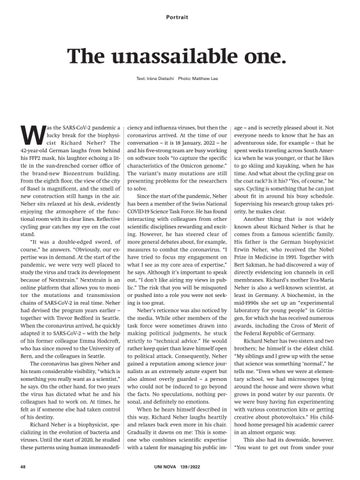Portrait
The unassailable one. Text: Irène Dietschi
W
as the SARS-CoV-2 pandemic a lucky break for the biophysicist Richard Neher? The 42-year-old German laughs from behind his FFP2 mask, his laughter echoing a little in the sun-drenched corner office of the brand-new Biozentrum building. From the eighth floor, the view of the city of Basel is magnificent, and the smell of new construction still hangs in the air. Neher sits relaxed at his desk, evidently enjoying the atmosphere of the functional room with its clear lines. Reflective cycling gear catches my eye on the coat stand. “It was a double-edged sword, of course,” he answers. “Obviously, our expertise was in demand. At the start of the pandemic, we were very well placed to study the virus and track its development because of Nextstrain.” Nextstrain is an online platform that allows you to monitor the mutations and transmission chains of SARS-CoV-2 in real time. Neher had devised the program years earlier – together with Trevor Bedford in Seattle. When the coronavirus arrived, he quickly adapted it to SARS-CoV-2 – with the help of his former colleague Emma Hodcroft, who has since moved to the University of Bern, and the colleagues in Seattle. The coronavirus has given Neher and his team considerable visibility, “which is something you really want as a scientist,” he says. On the other hand, for two years the virus has dictated what he and his colleagues had to work on. At times, he felt as if someone else had taken control of his destiny. Richard Neher is a biophysicist, specializing in the evolution of bacteria and viruses. Until the start of 2020, he studied these patterns using human immunodefi-
48
Photo: Matthew Lee
ciency and influenza viruses, but then the coronavirus arrived. At the time of our conversation – it is 18 January, 2022 – he and his five-strong team are busy working on software tools “to capture the specific characteristics of the Omicron genome.” The variant’s many mutations are still presenting problems for the researchers to solve. Since the start of the pandemic, Neher has been a member of the Swiss National COVID-19 Science Task Force. He has found interacting with colleagues from other scientific disciplines rewarding and exciting. However, he has steered clear of more general debates about, for example, measures to combat the coronavirus. “I have tried to focus my engagement on what I see as my core area of expertise,” he says. Although it’s important to speak out, “I don’t like airing my views in public.” The risk that you will be misquoted or pushed into a role you were not seeking is too great. Neher’s reticence was also noticed by the media. While other members of the task force were sometimes drawn into making political judgments, he stuck strictly to “technical advice.” He would rather keep quiet than leave himself open to political attack. Consequently, Neher gained a reputation among science journalists as an extremely astute expert but also almost overly guarded – a person who could not be induced to go beyond the facts. No speculations, nothing personal, and definitely no emotions. When he hears himself described in this way, Richard Neher laughs heartily and relaxes back even more in his chair. Gradually it dawns on me: This is someone who combines scientific expertise with a talent for managing his public im-
UNI NOVA
139 / 2022
age – and is secretly pleased about it. Not everyone needs to know that he has an adventurous side, for example – that he spent weeks traveling across South America when he was younger, or that he likes to go skiing and kayaking, when he has time. And what about the cycling gear on the coat rack? Is it his? “Yes, of course,” he says. Cycling is something that he can just about fit in around his busy schedule. Supervising his research group takes priority, he makes clear. Another thing that is not widely known about Richard Neher is that he comes from a famous scientific family. His father is the German biophysicist Erwin Neher, who received the Nobel Prize in Medicine in 1991. Together with Bert Sakman, he had discovered a way of directly evidencing ion channels in cell membranes. Richard’s mother Eva-Maria Neher is also a well-known scientist, at least in Germany. A biochemist, in the mid-1990s she set up an “experimental laboratory for young people” in Göttingen, for which she has received numerous awards, including the Cross of Merit of the Federal Republic of Germany. Richard Neher has two sisters and two brothers; he himself is the eldest child. “My siblings and I grew up with the sense that science was something ‘normal’,” he tells me. “Even when we were at elementary school, we had microscopes lying around the house and were shown what grows in pond water by our parents. Or we were busy having fun experimenting with various construction kits or getting creative about photovoltaics.” His childhood home presaged his academic career in an almost organic way. This also had its downside, however. “You want to get out from under your
















